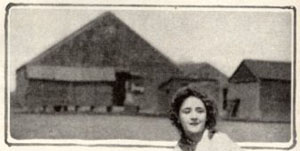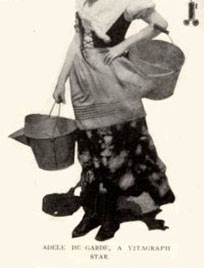"Where Are You Going, My Pretty Maid?"
"I'm Going A-Filming," Adele De Garde Said

In the true sense of the word, Adele should have answered, "I'm going a-starring — but not along the Milky Way!" At the age of eighteen, Adele De Garde is a starlet who intends to be a regular star, a veteranet of the films, with ten years' experience behind her to urge her forward and enable her to cope with both big and little filmy things. Ten years ago, when pictures were looked at with a bit of apprehension, Adele (at the age of eight) began to appear in Vitagraph pictures. A year later, when thinking people realized that the Motion Pictures had evidently come to stay, they began to take an interest in the names of the players. |
|
Good old John Bunny was the undisputed kind of comedy; nor was a picture ever complete without his able conspirator, Flora Finch. Maurice Costello and Florence Turner were the idols and ideals of many a young girl's dreams. And Adele De Garde and her little pal, Kenneth Casey, were the mischievous, spoiled, or ill-treated children around whom centered many a melodramatic plot. As new stars joined the Vitagraph forces, Adele and Kenneth played with them. Many a picture of the "two-generation" or "from-child-to-woman" type would open with Adele De Garde as its child heroine and finish with Leah Baird, Edith Storey, or Dorothy Kelly rounding out the plot when the child had grown up. If the good old days had been in the year 1918, we would have read about Kenneth Casey and Adele De Garde, co-stars, but their popularity and appeal suffered none whatsoever because of the fact that they were not heralded as co-stars. Many a Bunny comedy and many a Williams drama have been lightened effectively because of the two irrepressible ones. As the years grew, so did Adele, until finally she grew too large for little-girl-before-growing-up parts, and, with many sighs, her directors were forced to "pass her up" and cast anxious glances around for another promising child. Also Paul Kelly, who had joined the Vitagraph players a short time after Kenneth and Adele, had outgrown his cunning, childish ways. Loath to part with their two clever little players, the company produced some exceedingly funny pictures enacted entirely by children about fourteen or fifteen. These comedies — for they were comedies — proved extremely popular, because of the fact that they were so typical of children at that age. And so the years flew, until Adele had outgrown even these kinds of parts. About a year ago, when Vitagraph was casting "Within the Law," they were a trifle at a loss as to whom they should give the part of Aggie Lynch, a vivacious little parasite, a character on whom all the comedy relief of the play was dependent. After a careful study of the part, it was determined that Adele De Garde should have it, and those of you who have seen the Vitagraph Blue Ribbon "Within the Law" know how ably she portrayed the part. Hard-hearted New York press critics had nothing but lavish praise for her delineation of Aggie Lynch and pronounced it "a huge success," declaring that her portrayal equaled that of any of the well-known actresses who essayed the role on the legitimate stage. Adele De Garde was forced to delineate the character without the assistance of the witty and slangy lines that the stage made possible, but she "got it across in such a manner that even press critics had naught but good to say. Miss De Garde is the newest "O. Henry" girl, having given a most successful interpretation to the ingénue part in "Whistling Dick's Christmas Stocking." Very seldom — sadly seldom — do stage or screen children ever come back. They weep and laugh to our great delight for a few short years, and then disappear forever. Children are the small, yet vital, factors in many a picture, and when they outgrow their baby value they are often too quickly cast aside because of their lost babyhood. But now screen traditions are shattered! We actually have a player who has lived thru the three first ages of womanhood on the screen — babyhood, childhood and girlhood. It is interesting to note that, although Adele De Garde has of late appeared only intermittently upon the screen, the Vitagraph Company has never altogether released its hold on her. Hers is the charm that lasts; her personality is so piquant that she can portray any character — good, bad or indifferent — and her appeal is so strong that she can "get away with it." The day is passing when a pretty chorus girl can be plucked from the ranks and pushed thru a picture — "camera-trained" is as essential as "stage trained" in its field. Adele is a veritable child of the film. "Where are you going, my pretty maid?" "I'm going a-starring, sir," she said. Watch her — she will! |
 |